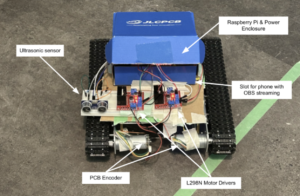The Epitome of Advanced Manufacturing: Self-Driving Vehicles
By Krish Modi
From the rapid advancement in the field of robotics and artificial intelligence (AI), new projects have taken birth that promise to change entire landscapes in sectors with a modern technological solution. One of the projects/endeavors is a unique combination of healthcare and self-driving vehicles; the disinfectant robot project challenge by NGen. If successful, the ambitious project aims to harness the potential power of self-driven technology so that autonomous robots are tasked to disinfect areas at hospitals. These are far-reaching developments more than just technological advancements, in the sense that they will go a long way in reducing disease transmission risk in buildings and medical facilities, a massive leap in public health and safety.
The Core of NGen’s Disinfectant Robot Challenge

This challenge was oriented toward self-driving and autonomous navigation capabilities, and the developed robots are supposed to navigate in the hospital environmentindependently. The aim of the research is that the robots could autonomously identify and disinfect areas of interest with no required human intervention. This requires a great combination of sensors, learning algorithms, and robotics engineering; in other words, it should help these robots understand their environments, avoid hitting any obstacle, and reach a target location placed within their environment.
Drawing Parallels with Personal Projects

In my Software Engineering 101 design class, my team built an autonomous tank for food delivery. Our project aimed to create a model tank capable of autonomously delivering food across the campus. It employed machine learning and computer vision for independent navigation from Point A to Point B, emphasizing autonomous navigation, much like NGen’s disinfectant robots.
Utilizing OpenCV for image processing, we differentiated between walkable paths and non-walkable areas, crafting a navigable map of the university’s complex terrain. This process involved converting images to black and white to define paths clearly and using algorithms to chart the most efficient routes, mirroring the technological sophistication needed for the disinfectant robots.
Moreover, our reliance on Dijkstra’s algorithm for pathfinding and ultrasonic sensors for object detection and avoidance shares a foundational similarity with the requirements for the successful operation of disinfectant robots in cluttered or dynamically changing environments such as a hospital room.
The Future of Robotics and AI in Public Health
The essence of both projects underscores the cutting edge of robotics and AI: achieving autonomous navigation is not just a matter of technological prowess but also ensuring safety, efficiency, and reliability. Robots capable of independently performing tasks such as disinfection could significantly impact maintaining cleanliness and hygiene in public spaces, especially in the face of pandemics or outbreaks.
The integration of AI and robotics in advanced manufacturing like NGen’s disinfectant robot challenge and the Autonomous Tank for Food Delivery points towards a future where autonomous machines play a crucial role in our daily lives. From ensuring our environments are clean and safe to delivering our meals, these technologies are set to provide innovative solutions to real-world challenges, making our lives easier and safer.
Advanced Manufacturing: Clean, High-Tech, and Innovative
This project exemplifies the transition of advanced manufacturing from its outdated perception of being dirty and old-fashioned to a future where clean, high-tech, and innovative solutions lead the way. Today’s advanced manufacturing landscape is vibrant and dynamic, characterized by cutting-edge technologies, sustainability, and efficiency.
Projects like the NGen disinfectant robot challenge and the Autonomous Tank for Food Delivery highlight the sector’s commitment to leveraging the latest in AI, robotics, and automation to solve real-world problems. These initiatives are deeply rooted in improving public health, safety, and overall quality of life, showcasing the potential of advanced manufacturing to transform our world through high-tech, clean, and innovative solutions.
As we look forward, it’s evident that advanced manufacturing will continue to shatter stereotypes, championing projects that are not only innovative but also critical for addressing the modern world’s challenges. The dawn of disinfectant robots is just one example of how technology can serve humanity, promising a future where advanced solutions lead to a healthier, safer, and more efficient world for everyone.
Check out more content from the NGen Youth Team.
For more innovative projects, visit NGen.
